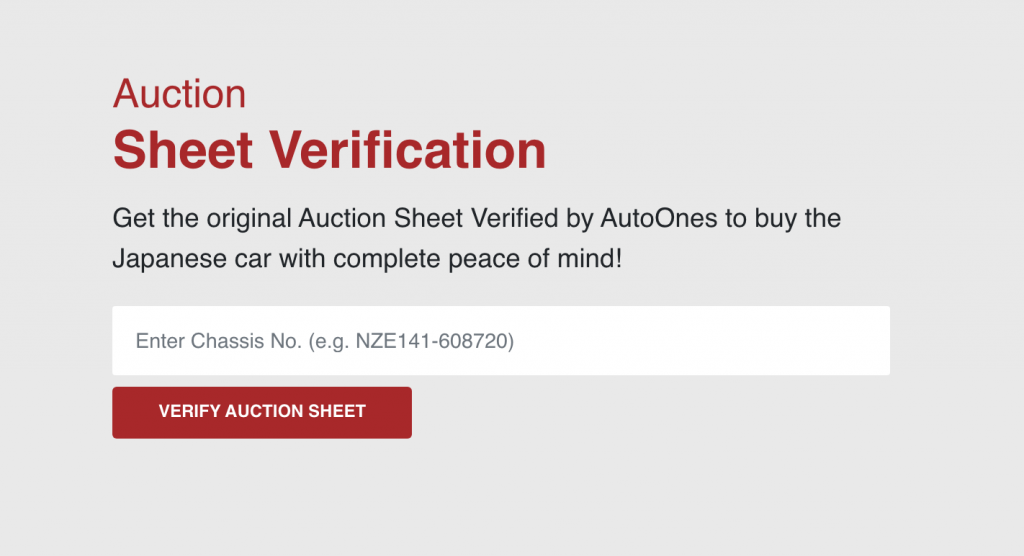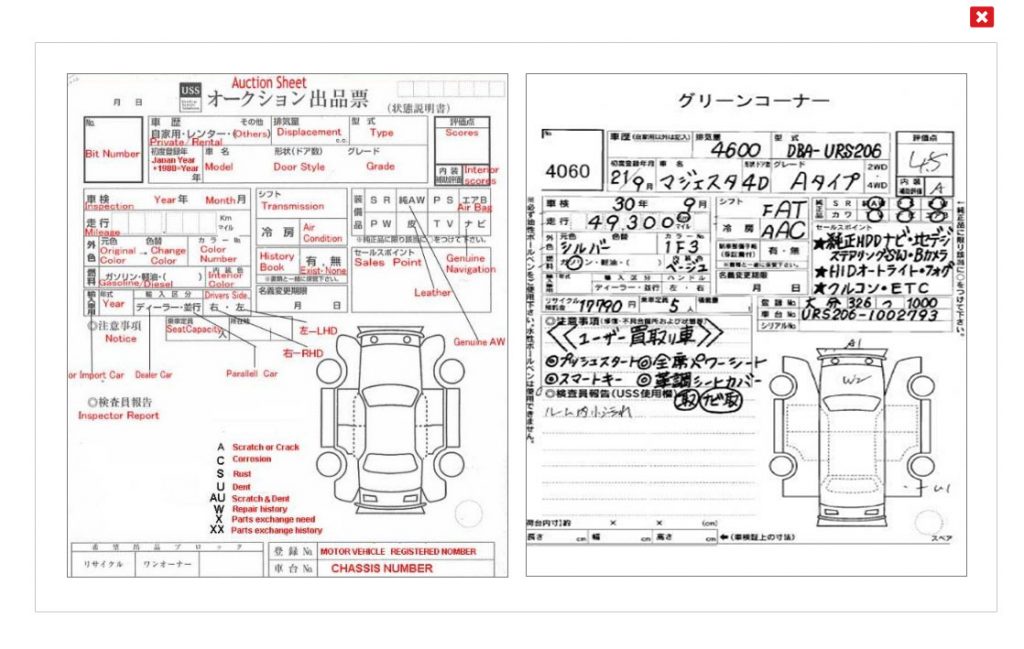What is an Auction Sheet?
An auction sheet is a paper that helps the buyers to identify Japanese used car conditions, its means you will see the old situation of the vehicle.
Why Do We Need an Auction Sheet?
We need an auction sheet to get/ acquire real-time auction grades, conditions information, and mileage. It helps to protect from vehicles that have been involved in accidents, fraud and also from the vehicles that have been repaired. It also protects from damage, altered and turn over/ flipped meters cars, and fake auction sheets.
Actual Mileage Grade and Condition:
Auction sheet have the all report regarding actual grade mileage and condition of the car, with the help of the auction sheet you can judge your car previous and new condition. Auction sheet saved you from reversed meter vehicles and other accidental graded cars like RA, R and ***.
Protection From Scam and Forged Sheets:
Auction sheet verification protects you from scammers and fake auction sheet, like somebody can prepare a fake report you can check the orignal auction sheet by chassis number.
Protection From Repaired and Accidental Vehicle’s:
Auction sheet can save you from repaired vehicles and accidental cars. You can judge the accidental cars and airbags.
How to Verify Auction Sheet?

We need an auction sheet to get/ acquire real-time auction grades, conditions information, and mileage. An auction sheet helps to protect from fraud vehicles that are involved in accidents & repaired. It also protects from damage, altered and turn over/ flipped meters cars, and fake auction sheets.
You can verify auction sheet from autoones.com. Go to the auction sheet verification page just enter the chassis number, after payment get your auction sheet link by email.
How to Read Auction Sheet ?

The auction sheet gives us basic information about the car, this information includes the lot number of the car, production month, and year, body type, engine displacement, car type, interior, and exterior parts, chassis code, chassis number.




Exterior Auction Grade:
Auction grade is the rating system of a car. Numeric figures are used for the graded car. The decrease in the figures is the decrease in the standard of the car.
Grade S:
Grade S is considered a brand-new car. The mileage of the car is under 5,000 km. The whole condition of the car is new and good. There interior and exterior of the car are spotless
Grade 6:
It is considered the highest grade that is used for like a brand-new car. This car is driven less than 30,000 km. The interior and exterior condition is clean.
Grade 5:
The condition of the vehicle is good and new. There are no dents and repair scratches on these cars and drive less than 60,000 km.
Grade 4.5:
These cars are mostly in very good condition and slightly used. These cars may have some minor faults and scratches. The engine has not been repaired. These kinds of cars are less driven.
Grade 4:
These cars are very good better than average condition and used with minor faults. These cars may have some small scratches and dents.
Grade 3.5:
These types of cars are in good condition with some faults. There are small scratches and dents on the cars. There is no history of a major crash.
Grade 3:
These kinds of cars are in average condition. There are large scratches, dents, and repair-marks on the cars that are the reason for their lower grade. These types of cars may have accident and damage history and require inside and outside maintenance. The engine condition may not be excellent.
Grade 2:
These cars indicate rusty and poor condition and sometimes indicate the presence of corrosion holes. These cars have a major transformation, it could be missing their original engine. These cars have accident damage and may have not been repaired.
Grade RA:
These types of cars have average accident damage, usually structural damage, and are heavily repaired and modified.
Grade R: it is used for the repaired car. These cars are involved in a major accident and one or more body parts must be replaced. Due to accidental damage engine may not be in working condition.
***
These cars have major mechanical or body imperfections. These cars have been accident damage, fire, and engine problem. These types of cars are not in working condition. There is no claim.
Interior auction grade:
In auction sheet alphabets are used for interior auction grade. Grades from A to D decrease the car standard.
Grade A:
Grade A is used for the new car. These cars have excellent interior condition with no imperfections or faults.
Grade B:
Grade B is used for very clean and fine condition cars. These cars are slightly dirty.
Grade C:
Grade C is used for average condition cars. there are some minor stains and cigarette burns.
Grade D:
Grade D is used for dirty-condition cars. There are major cigarette burns, tears, and other interior damage.
Auction Sheet Explained:

Here are some keys on the auction sheet that show all common alphanumeric signs and their meaning.

Scratches:
To mention scratches on the car code, “A” is used.
“A1” is used for a small scratch on the car.
“A2” is used for the medium scratch on the car
“A3” is for the large scratch on the car.
Dimples:
In the auction sheet code “E” is used for dimples on the cars.
“E1” is used for a minor dimple.
“E2” stands for several dimples.
“E3” stands for many dimples on the car.
Dents:
Here code “U” is used for dents.
“U1’ is used for minor dents.
“U2” is used for medium dents.
“U3” is used for large dents.
Repair mark:
Repair mark means bodywork is not flawlessly, here code “W” is used for repair mark.
“W1” is used for slight repair which is faintly identified.
“W2” is used for medium repair.
“W3” is used for major repair.
Rust:
The surface orange discoloration is called rust and here code “S” is used for rust.
“S1” is used for minor rust on the surface.
“S2” is used for heavy rust on the surface.
Corrosion:
Corrosion means the orange discoloration is peeling away. Here the key “C” is used.
“C1” is usedfor light corrosion on the surface.
“C2” is used for the severe corrosion on the surface.
Replaced parts:
The key “X” is used for replacing parts.
“X” is used for parts that need to be replaced.
“XX” shows parts have been replaced.
Cracks:
The key “Y” is used for cracks.
“Y1” shows small cracks on the surface.
“Y2” shows medium cracks on the surface.
“Y3” shows big cracks on the surface.
Paintwork:
Here key “P” is for paint mark.
“P1” shows minor paintwork damage.
“P2” shows medium paintwork damage.
“P3” shows major paintwork damage.
Windscreen issues:
“X1” shows small cracks on the windscreen around about 1cm.
“R” shows repaired crack on the windscreen.
“RX” shows repaired crack on the windscreen but needs to be replaced.
“X” shows cracks on the windscreen and needs to be replaced.
“G” is used to show stone scratches in the glass.
“B” is used to show dent with scratch.
Conclusion:
So, we conclude that the auction sheet is the x-ray of the Japanese used cars that show the real and old condition of the car. In the auction sheet grades are mentioned according to the condition and mileage. The whole data about the car are mentioned in numbers or codes and in English that can be easily understood. The auction sheet helps the buyer to avoid buying damaged and fraudulent cars and to choose 100% original cars with an exact reading. It also helps to analyse the market value of the car.
